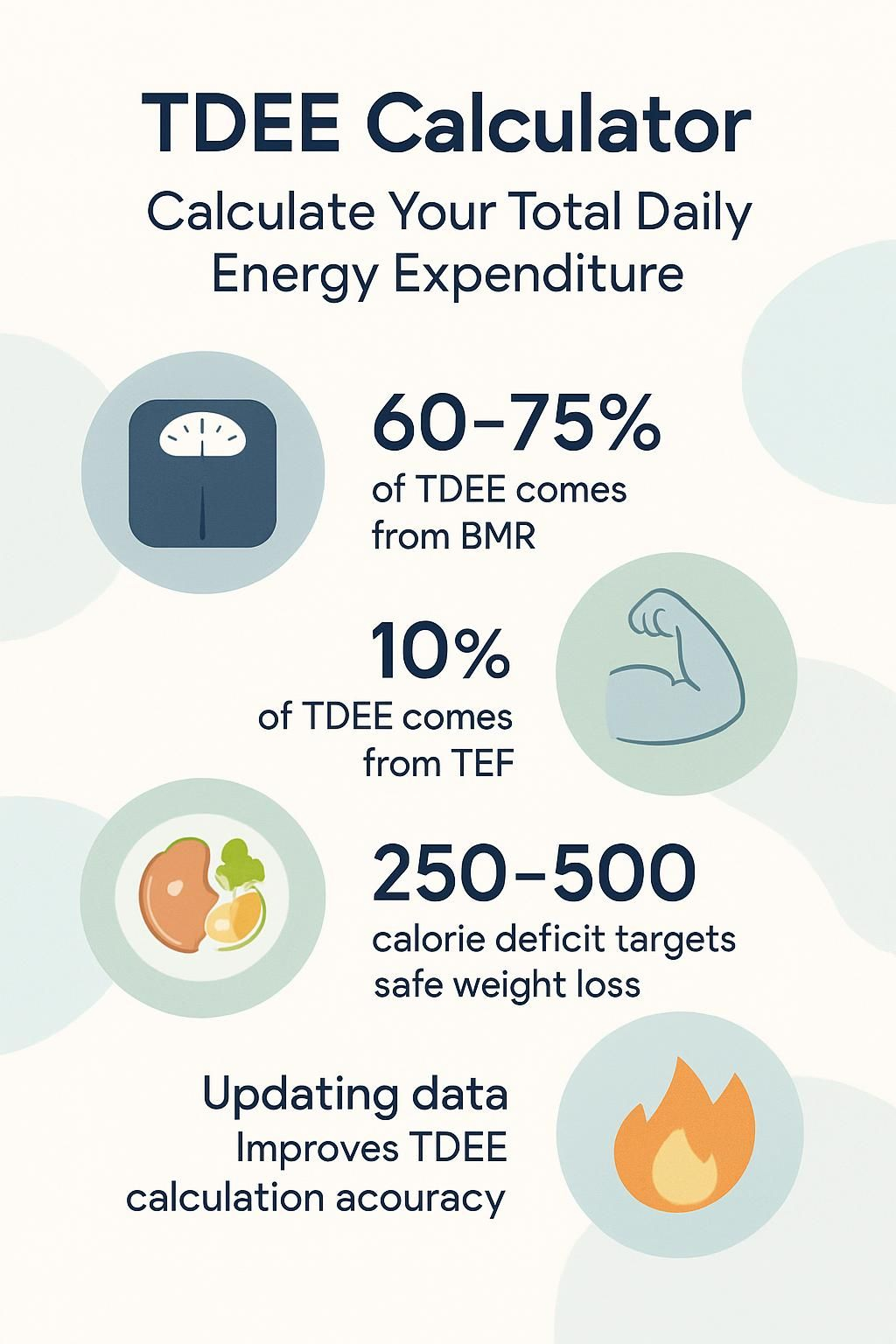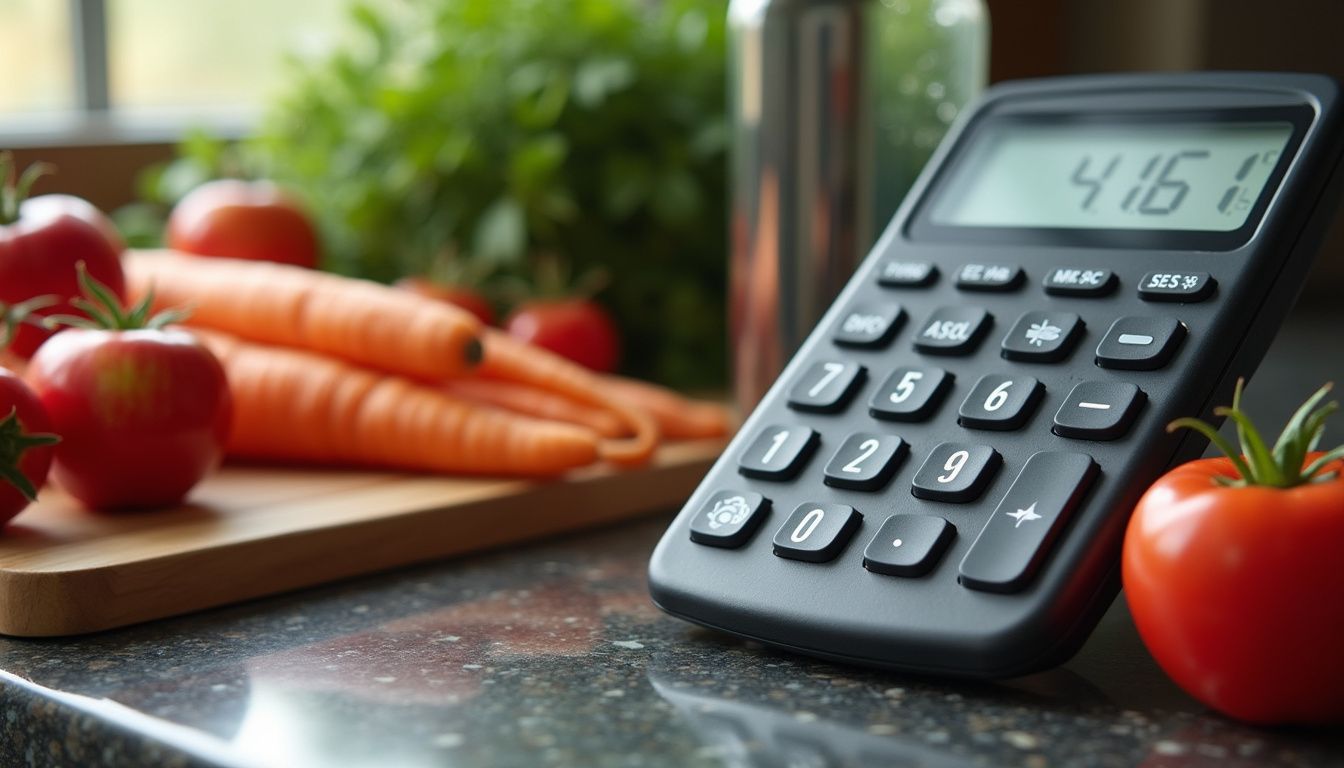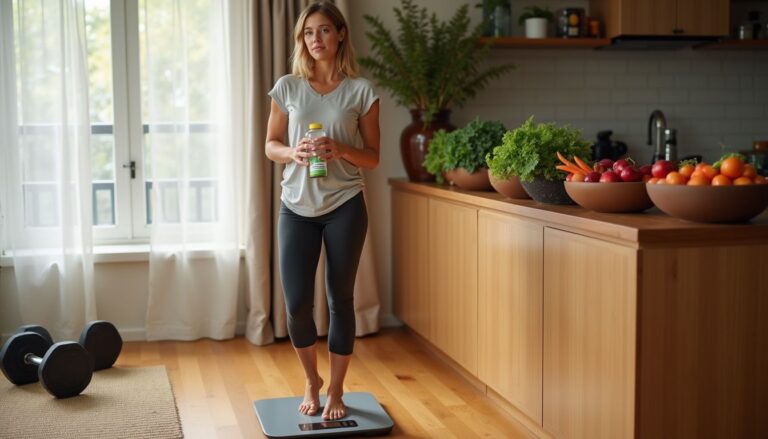TDEE Calculator: Calculate Your Total Daily Energy Expenditure
Our Nutrition Assistant AI Suite will transform your body. You will lose fat, get toned, and build muscle. Gain confidence and optimal health.
Figuring out how many calories you burn each day can feel confusing. A trusted TDEE calculator helps by estimating your total daily energy expenditure using simple inputs. I use it to set calorie goals that fit my life and my body.
This guide explains what TDEE means, why it matters, and how to apply it. You will see how age, weight, height, sex, and activity level shape calorie needs. I also share clear steps for using your results in everyday meals and training.
Key Takeaways
- TDEE calculators rely on validated equations, such as Mifflin-St Jeor and Katch-McArdle, that use age, sex, weight, height, and activity level to estimate daily calorie needs.
- Basal Metabolic Rate, the energy used at rest, averages 60 to 75 percent of TDEE. The Thermic Effect of Food is about 10 percent, and protein raises this effect more than carbs or fat.
- Choosing the correct activity multiplier is crucial. Overstating workouts can add hundreds of calories per day and slow progress.
- For safe fat loss, a daily calorie deficit of 250 to 500 can lead to about 0.25 to 0.5 kg per week while helping protect muscle.
- Updating your stats improves accuracy as weight and muscle change. Muscle mass shifts can raise or lower energy needs at the same body weight (Schoenfeld and Aragon, 2018).

What is Total Daily Energy Expenditure?

Total Daily Energy Expenditure, or TDEE, is the energy your body uses in a full day. It covers everything you do, from sleeping to training. Knowing your TDEE helps me match my calorie intake to my goals.
What does TDEE mean?
TDEE is the total number of calories your body burns in 24 hours. It includes your Basal Metabolic Rate, or BMR, which is energy used at rest for basic functions like breathing and circulation. It also includes exercise activity thermogenesis, non-exercise activity thermogenesis, and the thermic effect of food, which is the energy used to digest meals.
To estimate TDEE, calculators use your age, sex, weight, height, and activity level. They apply a scientific equation, such as Mifflin-St Jeor. The first time I used one, I discovered I was undereating for my training and felt better once I adjusted.
Calculating TDEE often reveals how much energy your body actually needs each day.
Why is TDEE important for health and fitness?
When I know how many calories I burn, I can plan meals that fit my goals. TDEE is the starting point for weight loss, weight gain, or maintenance. It helps me avoid eating too little, which can harm recovery, or eating too much, which can slow progress.
It also supports realistic training plans. A correct estimate lets me align nutrition with my workouts and day-to-day movement. For medical concerns or complex needs, I ask a healthcare professional for guidance based on formulas like Mifflin-St Jeor or the Harris-Benedict equation.
Components of Total Daily Energy Expenditure
TDEE comes from several parts. Each piece adds to the calories you burn across a normal day.
What is Basal Metabolic Rate (BMR)?
Basal Metabolic Rate is the energy your body uses at rest to keep vital organs working. Common equations, such as Mifflin-St Jeor and Harris-Benedict, use age, sex, weight, and height to estimate this number. BMR is shown in calories per day, before adding movement or digestion.
BMR is the largest piece of TDEE, often 60 to 75 percent. If I know my body fat percentage, the Katch-McArdle formula lets me estimate BMR using lean body mass for extra accuracy.
BMR tells you the calories your body needs even if you rest all day.
The next part is the Thermic Effect of Food.
How does the Thermic Effect of Food (TEF) influence energy use?
TEF is the energy used to digest, absorb, and process food. It averages about 10 percent of total food energy. Protein increases TEF more than carbs or fat, so higher protein meals raise calorie burn slightly through digestion.
Meal choices change TEF from day to day. Some calculators include TEF in their estimate. While it is smaller than BMR or activity, it still matters if you want a precise daily number.
What role does Non-Exercise Activity Thermogenesis (NEAT) play?
NEAT is the energy you burn outside of structured exercise. It includes walking at work, standing while cooking, cleaning, and even fidgeting. People who move more during the day can burn far more than those who sit most of the time.
NEAT can vary by as much as 2,000 calories per day between individuals. Activity multipliers in TDEE calculators include NEAT. That is why your movement habits matter, even without formal workouts.
How does Exercise Activity Thermogenesis (EAT) affect TDEE?
EAT is the energy burned in planned exercise, like running, lifting, or cycling. TDEE calculators factor EAT through activity multipliers that reflect frequency and intensity. More or harder sessions lead to higher total energy needs.
EAT is separate from NEAT and TEF in common methods such as Mifflin-St Jeor or Harris-Benedict. I pick a multiplier that matches how often and how hard I train. Twice-daily sessions raise TDEE much more than a short walk.
How is Total Daily Energy Expenditure Calculated?
TDEE comes from equations that estimate BMR, then adjust for daily movement and digestion. Age, sex, weight, height, and activity level shape the final number, which is the calories your body needs each day.
What is the Mifflin-St Jeor Equation?
The Mifflin-St Jeor equation estimates how many calories your body needs at rest based on age, sex, weight, and height. It has been well supported in research since 1990 and performs well in the general population. Most reliable TDEE calculators use it as the default BMR method.
I use Mifflin-St Jeor to find my BMR. Then I apply an activity multiplier to reach my TDEE. This helps me decide how much to eat to lose fat, maintain weight, or build muscle.
How does the Katch-McArdle Formula work?
The Katch-McArdle formula estimates BMR using lean body mass. It works best if you know your body fat percentage. People with more muscle, such as athletes, often get a more precise estimate from this method.
For instance, if I weigh 170 pounds at 15 percent body fat, my lean mass is about 145 pounds. Using that number tends to reflect my real energy needs at rest better than total weight alone. This can improve planning during a weight loss journey.
What are Activity Multiplication Factors?
Activity multipliers scale your BMR to match daily movement and training. Picking the correct level is key to an accurate TDEE.
- Sedentary (1.2): Little or no exercise; TDEE sits close to BMR.
- Light Activity (1.375): Light exercise 1 to 3 times per week, or work that includes some standing.
- Moderate Activity (1.55): Moderate training 3 to 5 times per week, or frequent movement during the day.
- Heavy Activity (1.725): Hard training 6 to 7 days per week, or very demanding physical work.
- Very Active or Extra Active (1.9+): Daily intense training or extremely active jobs; energy needs peak here.
- Accurate selection matters: A correct factor aligns TDEE with real movement.
- Wrong choice carries costs: Overestimating can drive fat gain; underestimating can cause fatigue.
- Frequency and intensity both count: The multiplier reflects how often and how hard you train.
- Honest input improves results: The calculator depends on your true activity data.
These multipliers bridge BMR and real life. They set calorie targets for weight loss, maintenance, or muscle gain.
How Do You Use a TDEE Calculator?
I use a TDEE calculator to estimate daily calories based on my details. It shows whether I should eat more or less to match my goal.
How do you input your personal data?
I enter my age, height, weight, and sex. I can use feet and inches, or centimeters. For weight, I pick pounds or kilograms. The tool accepts ages from 18 to 80.
I also select my activity level, from Sedentary to Athlete. If the option exists, I add my body fat percentage to improve accuracy with the Katch-McArdle formula. Then I confirm Imperial or Metric units before checking my results.
How do you understand your TDEE results?
The results show my maintenance calories per day and week. Many tools also display calorie targets for Mild Loss, Moderate Loss, Mild Gain, and Moderate Gain, plus my BMR.
Some calculators include macronutrient splits, such as Moderate Carb, Lower Carb, or Higher Carb, with grams for protein, carbs, and fat. I can view values in Calories or Kilojoules. This makes it easy to shape meals around a clear daily number.
How can you adjust calculations for accuracy?
I update my age, weight, and activity level whenever they change. If I know my body fat, I include it to refine my BMR. I also enter real training frequency and intensity to match my weekly routine.
For high accuracy, I talk with a healthcare professional, especially if I have medical conditions. Checking the calculator’s FAQ often helps fix common input errors. Formulas are sound, but personal variation always exists.
Benefits of Knowing Your Total Daily Energy Expenditure
Knowing TDEE helps me set realistic calorie goals and align meals with training. It turns guesswork into a simple plan I can follow day after day.
How does TDEE help with weight loss and calorie deficits?
TDEE gives me a target for creating a safe calorie deficit. I subtract 250 to 500 calories from my daily TDEE to aim for 0.25 to 0.5 kg per week. This pace supports fat loss while helping protect muscle.
Accurate estimates help me avoid eating too little or too much. They also give me confidence that my plan is sustainable rather than extreme.
How can you use TDEE for weight maintenance?
Matching intake to maintenance TDEE keeps weight stable. I set meals near my daily estimate, usually within 50 to 100 calories. This reduces swings and helps avoid yo-yo dieting.
If my activity or muscle mass changes, I recalculate and nudge intake up or down. Consistent input leads to steady, long-term results.
How does TDEE support weight gain goals?
TDEE shows my baseline. To gain weight, I eat above maintenance. For building muscle, I choose a mild surplus for about 0.25 kg per week or a moderate surplus for about 0.5 kg per week.
Using a calculator helps limit extra fat gain while I add lean mass. Many tools also suggest macros that support strength and recovery.
How does TDEE optimize nutrition and training plans?
TDEE results make meal planning straightforward. I set protein and fat based on my body weight and adjust carb levels to fit my training focus. This keeps fuel and recovery in balance.
Structured nutrition paired with appropriate activity improves outcomes for muscle gain and fat loss. Research supports this approach for body composition and performance (Schoenfeld and Aragon, 2018).
Factors That Affect Total Daily Energy Expenditure
Several personal and environmental factors shift your TDEE. Understanding them helps you fine-tune your plan and avoid surprises.
How do body weight and composition influence TDEE?
Higher body weight usually means higher TDEE. Muscle tissue burns more calories than fat, even at rest, so more muscle often raises BMR. My TDEE climbed after I added muscle with regular strength training.
Calculators start with weight and can include body fat percentage for greater accuracy. As my weight or composition changes, I recalculate to keep targets current.
What impact do gender and age have on TDEE?
Sex and age strongly affect TDEE. Males usually have higher BMR due to greater muscle mass, which leads to higher TDEE. Switching the sex field in a calculator can change the estimate by several hundred calories per day.
As people age, muscle mass often drops, which lowers BMR and TDEE. This change appears directly in equations that include age.
How does activity level and lifestyle affect TDEE?
Activity level and lifestyle shape daily energy needs. Sedentary people have lower TDEE than those who train and move more. Multipliers capture both how often and how hard you exercise.
Work days with extra walking or a sport session can raise my TDEE compared to long periods of sitting. NEAT and EAT together explain much of this difference.
What environmental and physiological conditions change TDEE?
Extreme temperatures can raise energy use because the body works to keep a stable core temperature. Illness and physical stress also increase calorie needs as the body repairs and recovers.
Gains in muscle mass raise resting calorie burn. Higher protein intake increases TEF a bit, which can shift daily totals upward. Regular recalculation keeps your plan aligned with current conditions.
Common Mistakes in Calculating Total Daily Energy Expenditure
Small errors in setup can lead to big gaps in results. I try to avoid these common mistakes so my plan stays on track.
Why is ignoring activity multipliers a mistake?
Skipping or misusing activity multipliers throws off TDEE. These factors reflect how much you actually move, including NEAT. If I choose the wrong one, my calorie target will not match my real life.
Clear definitions of frequency and intensity support each category. Picking the correct level leads to safer and more effective results.
What happens if you overestimate or underestimate exercise levels?
Overestimating exercise inflates TDEE and often leads to unwanted weight gain. Saying I train very hard for two hours when I do only 30 minutes at a moderate pace sets my calories too high.
Underestimating creates a larger deficit than planned. I have felt tired and stalled when I logged less activity than I actually did. Honest inputs are essential for reliable guidance.
How do BMR and TDEE differ?
BMR is the energy you burn at complete rest for vital functions. It does not include movement, digestion, or daily tasks. In research settings, it is measured under strict conditions with no recent activity or food.
TDEE builds on BMR by adding activity and TEF. It always equals or exceeds BMR because it reflects real life. Seeing both numbers helps me learn how movement changes my daily needs.
How Can You Use TDEE for Weight Management?
TDEE turns big goals into daily actions. I use it to plan fat loss, muscle gain, or stable weight with clear steps.
How to create a calorie deficit for fat loss?
A calorie deficit means eating fewer calories than you burn. Here is a simple plan I follow:
- Use a TDEE calculator to find your daily energy needs from age, sex, height, weight, and activity level.
- Pick a target rate, such as 0.25 or 0.5 kg per week, for a steady pace.
- Subtract 250 to 500 calories from your maintenance TDEE.
- Track intake with an app or food diary to stay near the target.
- Include walking and resistance training to raise TDEE and protect muscle.
- Recalculate every few weeks as weight and activity change.
- Avoid extreme deficits that can cause fatigue, slow metabolism, or muscle loss.
How to build muscle with a calorie surplus?
After a fat loss phase, I shift to a surplus to support muscle growth. I keep it controlled to limit excess fat gain.
- Choose a mild gain, about 0.25 kg per week, or a moderate gain, about 0.5 kg per week.
- Add the needed surplus to your TDEE based on your goal.
- Use a validated calculator, such as one with Mifflin-St Jeor or Katch-McArdle.
- Set protein first, then balance carbs and fats to fuel training and recovery.
- Track weight, measurements, and performance each week.
- Recalculate every few months as body composition changes.
- Use a fitness tracker to reflect real activity in daily targets.
- Increase the surplus slowly if progress stalls.
- Apply evidence-based timing for key meals around training.
- Ask a healthcare professional for help if progress remains slow or if medical issues affect results.
How to adjust calories for maintenance?
Maintenance requires small, steady adjustments. I keep intake near my maintenance TDEE and make minor changes as needed.
- Calculate your current TDEE for daily and weekly maintenance.
- Weigh in weekly to confirm stability.
- Update age, weight, and activity every 4 to 8 weeks.
- Adjust intake by 100 to 200 calories if weight trends change for two weeks.
- Track steps or minutes of activity for a clearer picture.
- Use reminders in apps to update your stats.
- Plan meals that fit your maintenance range, especially on busy days.
- Consult a healthcare professional if weight trends shift without a clear reason.
- Set a monthly check-in to keep your plan aligned.
Tools to Improve Total Daily Energy Expenditure Accuracy
Simple tools make better inputs, and better inputs make better results. I like devices and apps that help me log movement and food with less effort.
How do fitness trackers help measure TDEE?
Fitness trackers log steps, activity minutes, and workout intensity. That data improves the activity multiplier you choose in a TDEE calculator. It also reduces guesswork and bias.
Syncing a tracker with your logs improves accuracy over time, especially when routines change. I find that steady tracking keeps my targets realistic as life gets busier or training ramps up.
What apps and digital calculators are best for TDEE?
TDEECalculator.net is a clear, trusted tool that uses validated formulas. It takes age, sex, height, weight, and activity level, then provides results in Calories and Kilojoules. I find it quick to use and easy to read. Calculator.net also offers a comprehensive TDEE calculator with similar features.
Many mobile apps include a TDEE tool and let you update stats over time. I like tools that store history so I can see trends and adjust faster during cutting or bulking phases.
When should you consult healthcare professionals about TDEE?
I reach out to a healthcare professional if I have a medical condition that affects metabolism or activity. Expert support helps me set a safe activity multiplier and interpret confusing results. If my numbers do not match my progress, I ask for help to find and fix the problem.
As my body changes, regular guidance keeps my nutrition aligned with my health. This is especially useful during recovery, pregnancy, or after major weight changes.
FAQs About Total Daily Energy Expenditure
Here are quick answers to common questions I hear about TDEE.
How often should I recalculate my TDEE?
I recalculate when my weight changes by at least five pounds or my activity level shifts. I also update as I age, because energy needs change over time. Doing this helped me stay on track after a 10 pound loss last year.
Is TDEE the same for everyone?
No. TDEE depends on age, sex, height, weight, body composition, and activity level. A 25-year-old male athlete will usually have a far higher TDEE than a 60-year-old woman with a sedentary lifestyle.
Personalized calculators use these inputs to produce your estimate. As exercise or muscle mass changes, your daily needs can shift too.
Can TDEE calculations assist with medical conditions?
TDEE can guide meal planning for conditions that require careful calorie control, such as diabetes or hypothyroidism. Illness often changes BMR and activity, so updated estimates help. A healthcare professional can use TDEE within a broader plan to support health and recovery.
During my own post-surgery recovery, tracking TDEE helped me avoid unwanted weight loss while I healed.
Conclusion
A TDEE calculator makes daily calorie planning simple. It shows how diet, movement, and habits add up and helps me choose targets for fat loss, muscle gain, or maintenance. With validated equations like Mifflin-St Jeor, I can set goals and adjust with confidence.
Use your estimate as a clear daily guide. Update it as your weight and activity change. For medical concerns, seek advice from a healthcare professional. TDEE turns your big goal into steady steps you can follow every day.
FAQs
1. What is a TDEE calculator and how does it work?
A Total Daily Energy Expenditure (TDEE) calculator estimates the number of calories your body uses in one day. It considers factors such as age, sex, weight, height, and activity level to provide an accurate calorie estimate for maintaining your current weight. Research from the National Institutes of Health supports using these variables for precise calculations.
2. Why should I use a TDEE calculator before starting a nutrition or fitness plan?
Using a TDEE calculator helps you understand how many calories you need each day based on your lifestyle and goals. This knowledge allows you to set realistic targets for losing fat, gaining muscle mass, or maintaining weight. A study published in the Journal of Nutrition Education found that individuals who tracked their energy needs achieved better results with diet changes.
3. How do physical activity levels affect my total daily energy expenditure?
Physical activity increases your calorie needs because movement burns more energy than resting states alone. For example, someone with a sedentary job will have lower TDEE compared to an athlete training several hours per week. The Centers for Disease Control and Prevention provides guidelines showing that higher intensity exercise leads to greater caloric burn.
4. Can personal experience help me use my TDEE results effectively?
Applying your own data makes tracking progress easier over time; when I first used a TDEE calculator after college sports ended, I realized my old eating habits no longer matched my new desk job routine which led me to adjust portion sizes accordingly and maintain healthy body composition without guesswork.
Summary:
A Total Daily Energy Expenditure calculator gives tailored calorie recommendations by analyzing individual traits like age and activity level; credible sources confirm its accuracy for planning nutrition strategies; adjusting intake according to real-life routines ensures lasting success in health management.







